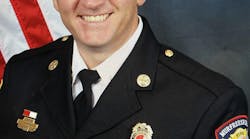An indication of LOSAP's value came last year in Pennsylvania, where the statewide fire department advisory board unanimously supported legislation to facilitate LOSAP. According to John Brenner of the Pennsylvania Fire Services Institute, the board recognized that it is "an important tool" for retaining volunteers.
Dave Wyrwas, a vice president of VFIS Inc., an insurance company that is a large LOSAP plan administrator, estimates that as many as 5,000 of the nation's 27,000 volunteer fire departments have created retirement benefit programs. Laws in at least 40 states authorize LOSAP-type plans. Indeed, Wyrwas notes that some states, such as Oklahoma, have plans covering every volunteer in the state. Although there are a variety of plan formats, most follow a similar model. Volunteers receive points for responding to calls, standing by in fire stations, and attending training sessions, meetings, drills and other activities. Those who receive more than the minimum required number of points during the year are given a year's credit toward the pension. After receiving a minimum number of years of credit, the volunteer is eligible for a monthly pension beginning at a specified age.
"Departments can place a value on what's important to them by the way that they set up their point system," says Emmaus, PA, Fire Chief Robert Reiss, a leading LOSAP proponent. Reiss says it is doubtful that many people initially will become volunteers merely because of LOSAP benefits. The reward is too distant for a young adult just joining a department. However, LOSAP has proven to be a powerful retention tool for experienced volunteers because they can visualize receiving the pension payments. And the benefits of retaining experienced volunteers should be evident to any department leader.
Unfortunately, LOSAP has run afoul of tax law. Under federal tax law, a volunteer is considered to receive a taxable benefit each year that he or she accrues credit toward a retirement pension. Section 457 of the Internal Revenue Code lists requirements that must be met by LOSAP programs (known in legal jargon as "deferred compensation plans") to avoid creating this tax liability for volunteers each year. One requirement is that the annual award cannot exceed the lesser of $7,500 or one-third of the individual's compensation. Since volunteers receive little or no compensation, it is virtually impossible for them to meet the second part of this test. Thus, volunteers have been potentially liable to be taxed on the value of LOSAP benefits as they accrue. (There is a complicated formula for determining the value of each year's LOSAP credit based on a person's number of years until retirement and the amount of the pension to be paid at retirement.)
Last year, after years of effort by the National Volunteer Fire Council and others, Congress enacted legislation to correct this. The new law exempts most LOSAP plans from Section 457. Benefits under programs that qualify for this exemption will be taxable only in the year that they are received, not in the year in which they are earned. The law also specifies that LOSAP benefits are exempt until paid if they provide awards only to "bona fide volunteers" or their beneficiaries. Additionally, the award accrued to an individual for any year of service must be less than $3,000. No volunteer may have access to the benefit before retirement, under a doctrine known as constructive receipt. Unless all of these tests are met, the benefit is immediately taxable.
A "bona fide volunteer" must be performing firefighting and fire prevention services, EMS or ambulance services. The only compensation that a volunteer may receive is reimbursement for reasonable expenses, or reasonable benefits and nominal fees. Presumably, this allows paid on call volunteers to participate in LOSAP. But this begs the question of whether the payments received are nominal and reasonable, and that must be decided on a case-by-case basis. According to Wyrwas, it is likely the Internal Revenue Service will follow the U.S. Department of Labor, which must distinguish between volunteer and paid firefighters for purposes of the Fair Labor Standards Act. So far, Labor has ruled in only a few cases.
The $3,000 limit on benefits that participants may receive in any single year is especially important when plans are created. Wyrwas believes that ceiling is adequate for even the most generous LOSAP benefit formulas. However, there is a potential problem when a program is created and long-term volunteers are granted credit for prior years of service. The benefit they accrue in that first year may well exceed $3,000, so it must be made clear that this benefit is to be allocated over the prior years of service and is not a one-year benefit.
It is up to fire departments to use LOSAP as one tool for retaining experienced volunteers. But there are potentially difficult issues that must be addressed in the creation of any LOSAP system. No department should get involved without obtaining expert advice from a state or local pension agency, insurance company or lawyer who is an expert in pension plans.
Steve Blackistone, a Firehouse® contributing editor, is an attorney and a member of the Bethesda-Chevy Chase Rescue Squad in Montgomery County, MD.




